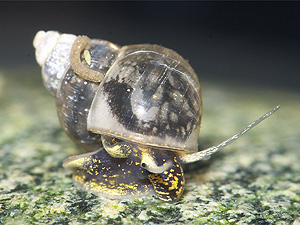EVOLUTION & SYSTEMATICS
Theopisthobranch group (formerly Opisthobranchia) was thought to have arisen from ancestral mesogastropod prosobranchs (Figure 21). It may share a common ancestor, which would have been torted with a gill, epibenthic, marine and have had a spirally coiled shell (Ruppert et al 2004).
The original Opisthobranchs diverged into several distinct lines, often exhibiting parallel or convergent evolution with each other. Opisthobranchs are gastropods that have specialized in the reduction and loss of shell and radiated into niches suitable for shell-less gastropods. This allows them to burrow, swim and use chemical defenses.
Opisthobranchs are polyphyletic, and probably arose from a torted, coiled, asymmetrical, prosobranch ancestor with a single gill in an anterior mantle cavity. Primitive opisthobranchs resemble mesogastropod snails and are difficult to distinguish from prosobranchs (Figure 20). They are asymmetrical and have a more or less typical spirally coiled, prosobranch-like shell. An operculum is present in primitive species and in many larvae, but is lacking in most adult opisthobranchs. Common trends, however, are a tendency toward shell reduction and loss, reduction of the mantle cavity and the accompanying loss of the original gill, detorsion, loss of coiling and development of secondary bilateral symmetry and secondary defenses to compensate for the reduction ofshell. Such defenses include skin glands that produce acid or noxious substances that repel potential predators, especially fish.
Opisthobranch taxa are noted for their extensive parallel evolution, and each of these trends has occurred more than once.
 Figure 20. Mesogastropoda, Cerithidea mezatanica (Carpenter 1857)
Figure 20. Mesogastropoda, Cerithidea mezatanica (Carpenter 1857)
W. Mexico to W. Panama
W. Costa Rica 36mm
 Figure 21. A prosobranch snail, Bithynia tentaculata. (Lars Peters)
Figure 21. A prosobranch snail, Bithynia tentaculata. (Lars Peters)
Figure 22. Phylagenetic tree for the Phylum Mollusca: Order Cephalaspida (Headshield Slugs), where Hydatina physis exist on the tree, branches out from Subclass Opisthobranchia (Sea Slugs), which branch out from Class Gastropoda (Coleman 2001)
|